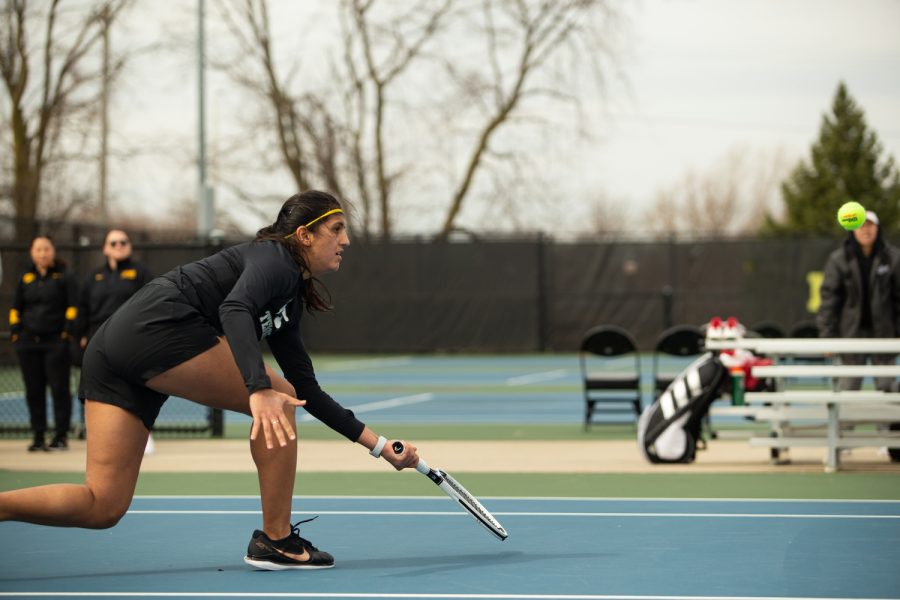Iowa women’s tennis team courts the elements as it embarks on outdoor play
Head coach Sasha Schmid and junior Vipasha Mehra talked with The Daily Iowan about adjusting to sun and wind, and how outdoor play can bring out the unexpected.
Iowa’s Vipasha Mehra during a doubles match against Indiana at the Hawkeye Tennis and Recreational Complex on Sunday, April 2nd. The Hoosiers defeated the Hawkeyes 4-2.
April 11, 2023
Iowa women’s tennis player Vipasha Mehra has dealt with the elements while on the court.
Whether that be the howling winds in Madison, Wisconsin, and Champaign, Illinois, during the Big Ten Tournament during her freshman and sophomore seasons, or in the unrelenting heat of Dubai during her high school years, the junior has competed in outdoor matches with harsh conditions.
“I’ve played in really humid conditions, like in Dubai,” Mehra said. “I literally, like, change my outfit every 10 minutes. It’s like, you warm up and you’re already drenched.”
Now playing in Iowa City, Mehra, who was originally from Canada, doesn’t experience such extremes but still deals with the adversity created by outdoor play. She described how Midwestern winds oftentimes impact her strategy in singles.
“So, if you’re against the wind, you want to hit through the ball more and make sure you don’t hit the ball too short,” Mehra said. “And if you’re with the wind, just step up to the baseline and move to the net.”
The Hawkeyes began outdoor play on April 2 at home against Indiana and played their two most recent matches — road contests against Penn State and Ohio State — outside as well.
Hawkeye head coach Sasha Schmid agreed with Mehra and said adjusting to outdoor weather part-way through the spring each year is a component of her coaching. For example, with air resistance being a factor outside, the ball doesn’t travel as fast as it does indoors.
“Sometimes you really need to make more balls; you can’t hit winners as easy,” Schmid said of outdoor matches. “There’s sun, there’s winds, there’s just a lot more that can affect your play … When you’re hitting with the wind, you need more topspin, and the wind can change. So, you’re really trying to be smart and make real-time adjustments that you don’t ever have to think about when you’re inside.”
The Hawkeye roster this season features players with mixed degrees of experience with outdoor play. While freshman Daianne Hayashida, who hails from Lima, Peru, said nearly all of her matches were outdoors growing up, other players such as sophomore and Czech Republic native Barbora Pokorna had to deal with long winters that sometimes stretched into the spring.
The Big Ten covers a vast geographical range, from Nebraska to New Jersey, and is soon to include California when USC and UCLA join in August 2024. Schmid finds that the conference has grown used to transitioning from indoor to outdoor competition.
“I think for Big Ten teams, you know, we’re always going to be having to make the move from indoor tennis to outdoor tennis,” Schmid said. “It’s really hard to control [the weather], you know, and so I couldn’t control the fact that we didn’t have any practices outside before we had to play a match outside … we know that, so we really try to be mentally tough and not let it be an excuse.”
Even with such volatility, the transition to the outdoor season does have its advantages. Mehra remembers times when the wind helped her score.
“I’ve hit balls that weren’t supposed to go in, and then the wind brings it in,” Mehra said.
The Hawkeyes’ next matches on the schedule are home dates against Rutgers on Friday at 5 p.m. and Maryland two days later at 10 a.m.
The temperature against the Scarlet Knights is projected to be in the 70s for much of the afternoon, boding well for outdoor competition. Rain is expected when the Terrapins come to town, so that match will most likely be kept indoors.
Even though Schmid knows she can’t control the weather, she realizes that she can determine how her team responds to the elements, which can dictate the result of a match.
“I think every time you play outside and there’s wind, it changes the match for sure. It really does,” Schmid said. “I think it’s just a matter of which team handles it better.”



